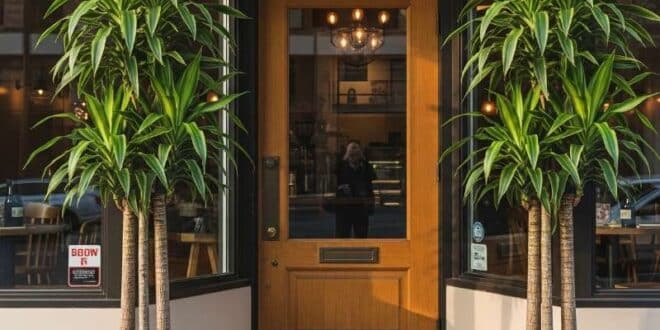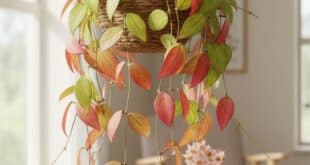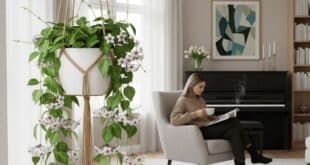Meet the Corn Plant (Dracaena Fragrans)
Ever wished for a tall, elegant houseplant that looks incredibly stylish but asks for very little in return? Say hello to the Corn Plant! This beloved classic (Dracaena fragrans is its fancy scientific name) is a true star in the indoor plant world, famous for its strong, woody “cane” stems and broad, often beautifully striped leaves. It really does look like a mini cornstalk, but much prettier!
Hailing from the lush forests of tropical Africa, the Corn Plant brings a touch of calm tropical elegance and impressive height to any room. It’s incredibly low-maintenance and even helps clean the air! Ready to add this striking and beneficial plant to your home? Let’s uncover all the secrets to making your Corn Plant not just survive, but truly thrive!
What Makes a Corn Plant So Unique? Its “Cornstalk” Stems and Strappy Leaves
When you look at a Corn Plant, you’ll immediately notice its distinctive appearance. It grows from a thick, upright, woody stem that looks a lot like a cornstalk, which is why it gets its common name! These stems are often cut at different heights before you buy them, giving the plant a charming tiered or bushy look.

From these “canes” sprout long, broad, and slightly arching leaves. These leaves are typically a vibrant green with stunning stripes down the middle or along the edges, usually in shades of yellow, lime green, or white. They add such a beautiful burst of color and texture, making the plant feel wonderfully lush.
Where Do Corn Plants Come From? Tropical Africa’s Forests
Your Corn Plant’s ancestors come from the warm, shady forests of tropical Africa, in places like Ethiopia, Sudan, and Tanzania. In their natural habitat, Coleus plants grow beneath the canopy of taller trees, thriving in filtered light and consistent warmth—conditions that mimic their ideal environment. This background perfectly explains why they’re so good at tolerating lower light conditions indoors and appreciate warmth in our homes. They’re built for a relaxed, under-the-canopy life!
What Are Its Other Names? “Cornstalk Dracaena” and Its Enduring Popularity
The most common nickname for Dracaena fragrans is “Corn Plant” or “Cornstalk Dracaena,” which perfectly describes its unique woody stem. This plant has been a consistent favorite in homes and offices for decades, and its popularity just keeps growing! It’s a classic for a reason – it brings reliable greenery, elegant height, and a truly fuss-free nature.
What Kinds of Corn Plants Are There?
While all Corn Plants share that familiar “cornstalk” look, they come in some lovely variations, mainly distinguished by their leaf patterns and colors!
Popular Corn Plant Varieties: A Rich Variety of Stripes
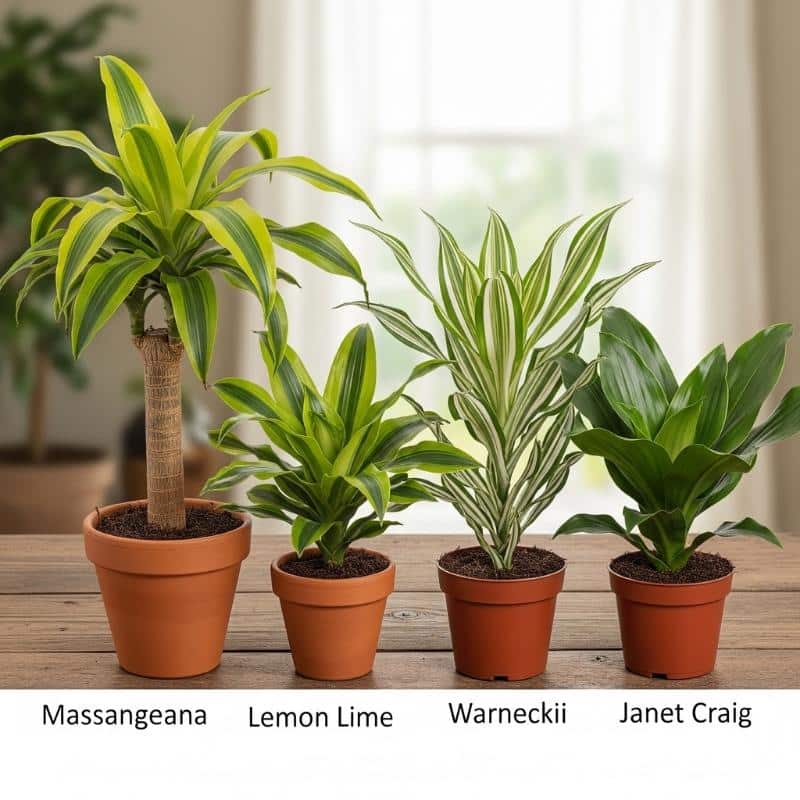
When people say “Corn Plant,” they’re usually talking about Dracaena fragrans ‘Massangeana’, but there are other beautiful types too:
| Type of Corn Plant | Key Features & Colors | Looks Like… |
| ‘Massangeana‘ | The classic! Broad green leaves with a bold, bright yellow or lime-green stripe right down the center. | The quintessential Corn Plant you often see, a striking pop of yellow. |
| ‘Lemon Lime’ | Very vibrant! Features brighter green leaves with bold stripes of a cheerful yellow or lime green. | An even brighter, more energetic version of the classic. |
| ‘Warneckii’ | Has narrower, more upright leaves, typically dark green with white or silvery-grey stripes along the edges. | A more streamlined look, often with multiple stems, very popular in offices. |
| ‘Janet Craig’ | Features solid, deep dark green leaves. No stripes, but incredibly tough and elegant. | A lush, dark green column of foliage, very resilient. (Note: often sold as a Dracaena deremensis cultivar) |
Leaf Looks: Colors, Patterns, and Size
The beauty of Corn Plants is all in those leaves! You’ll find them in various shades of green, from deep emerald to bright lime, often highlighted by bold stripes of yellow, white, or lighter green. These stripes can run down the center, along the edges, or be more subtle bands. The leaves are generally long, broad, and gracefully arching, creating a wonderfully full and lush silhouette.
Growth Habit: Upright and Tree-like
Corn Plants naturally grow upright, like a mini indoor tree. They get their height from those sturdy central canes. This upright growth makes them fantastic for adding vertical interest and a touch of architectural elegance to any room.
How Do You Take Care of Your Corn Plant?
Caring for a Corn Plant is wonderfully straightforward, making it a fantastic choice for both beginners and busy plant parents! They’re quite forgiving, which is always a bonus.

Corn Plant Care Summary
Here’s a quick overview of what your Corn Plant loves:
| Care Category | What Your Corn Plant Needs |
| Light | Bright, indirect light (best for color and growth, tolerates lower light) |
| Watering | Allow the top 1–2 inches of soil to dry before watering your Coleus thoroughly. If the leaf tips start to brown, switch to filtered or distilled water to prevent mineral buildup. |
| Temperature | Warm, 65-80°F (18-27°C); avoid cold drafts. |
| Humidity | Average indoor humidity; no special needs. |
| Soil | Well-draining, general-purpose potting mix with drainage holes. |
| Potting | Repot every 1-2 years when root-bound, usually in spring. |
| Feeding | Monthly during spring/summer with diluted balanced liquid fertilizer. |
The Right Light: Bright, Indirect Light is Ideal
Your Corn Plant loves bright, indirect light. Place your Coleus near a window that provides plenty of bright, indirect light. Avoid harsh direct sunlight, as it can scorch their delicate leaves and cause sunburn! While it can tolerate lower light conditions (which is why you see them in offices), its beautiful variegation (stripes) might fade in very dim spots, and growth will be slower.
Watering Smart: Consistently Moist, But Not Soggy!
Corn Plants prefer their soil to be consistently moist, but never soggy. Water your Coleus thoroughly when the top 1–2 inches (2.5–5 cm) of soil feel dry to the touch, ensuring consistent moisture without overwatering. This plant is pretty sensitive to overwatering, which is the number one cause of yellowing leaves and root rot. Make sure your pot has fantastic drainage! During the cooler, slower winter months, you can ease up on watering your Coleus, as its growth will naturally slow down and require less moisture.
💡 Important Watering Tip! Corn Plants are sensitive to fluoride and chlorine often present in tap water, which can cause leaf tips to brown. Using filtered or distilled water is ideal for keeping them healthy. If you notice persistent brown leaf tips (even when humidity is fine), try using filtered water, distilled water, or rainwater instead. This can make a huge difference!
Cozy Temperatures and Average Humidity, Please!
Your Corn Plant prefers warm temperatures, ideally between 65-80°F (18-27°C). It’s not a fan of cold drafts or sudden temperature drops, so keep it in a snug spot! Good news: unlike many tropical plants, Corn Plants are perfectly happy with average indoor humidity – no need for humidifiers here, which makes them even easier to care for!
Choosing the Right Soil and Pot: Drainage is a Must!
Your Corn Plant will be happiest in a well-draining, general-purpose potting mix. A high-quality indoor potting mix works perfectly for Corn Plants, providing the right balance of nutrients and drainage for optimal growth. As with almost all plants, always pick a pot with drainage holes! Corn Plants are quite tall, but they don’t need super frequent repotting; usually, every 1-2 years is plenty, or when you see roots clearly coming out of the drainage holes. Spring is the ideal time to repot Corn Plants, as they are entering their active growing season and can adjust more easily to their new environment.
Feeding Your Corn Plant: Light Meals During Growing Season
To fuel all that lovely growth, your Corn Plant will appreciate regular feeding during its active growing season (spring and summer). Use a balanced liquid houseplant fertilizer, diluted to half strength, about once a month. When fall arrives and winter sets in, stop feeding your Corn Plant entirely, as its growth slows during these cooler months and it requires less nutrition. Don’t forget to gently wipe dust off its leaves regularly – it helps them soak up light better!
What Are Common Problems with Corn Plants and How to Fix Them?
Corn Plants are generally pretty resilient, but they’ll definitely show you if something’s not quite right. Here’s what to look for:
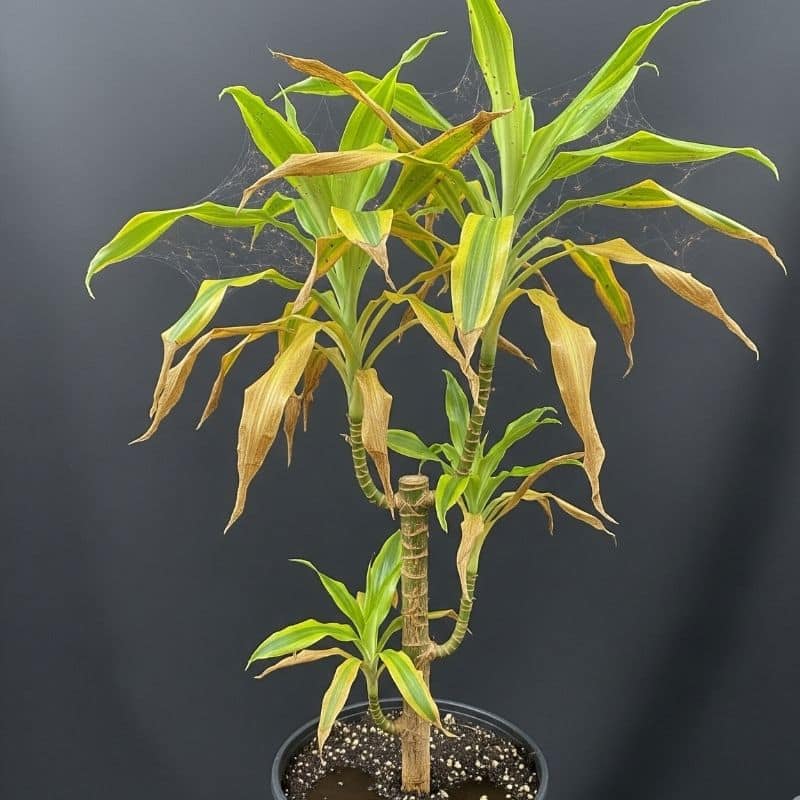
Common Corn Plant Problems & Solutions
| Problem | What It Looks Like | Common Cause(s) | How to Fix |
| Brown Leaf Tips | Leaf tips are dry, brown, or crispy | Fluoride/chlorine in water, inconsistent watering, low humidity | Use filtered/distilled water; water consistently; consider boosting humidity slightly. |
| Yellowing Leaves | Leaves turn yellow, often lower ones | Overwatering (most common), root rot, sometimes nutrient issues | Let soil dry more; check drainage; ensure adequate light & fertilizer. |
| Drooping Leaves | Leaves look limp/sad | Underwatering (thirsty) OR overwatering (root rot) | Check soil moisture: if dry, water; if soggy, let dry/check roots. |
| Leggy Growth/Fading Colors | Stretched out stems, stripes look dull | Not enough light | Move to a brighter spot with indirect light. |
| Pests | Tiny webs, sticky residue, small bugs | General plant stress, dry air | Inspect regularly. Treat with insecticidal soap or neem oil. |
| Root Rot | Mushy stems at soil line, foul smell | Persistent overwatering | Prevent with proper watering & drainage. If severe, repot, trim rotten roots. |
Is the Corn Plant Toxic? Safety for Pets
Yes, it’s very important to know: Corn Plants are considered toxic if ingested. They contain compounds called saponins that can cause irritation.
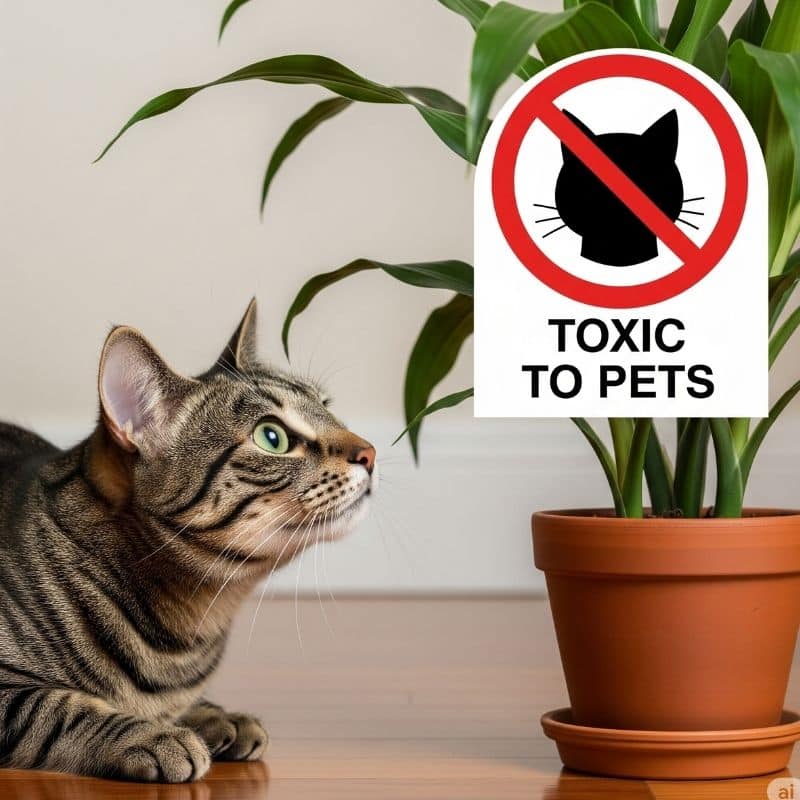
If your cats, dogs, or other pets chew on a Corn Plant, you might see symptoms like:
- Vomiting: This is the most common reaction.
- Excessive drooling.
- Weakness or lethargy.
- Dilated pupils (especially in cats): This is a unique symptom to watch for in felines.
While usually not life-threatening, it can cause significant discomfort for your pets. So, it’s highly recommended to keep Corn Plants out of reach of curious pets and small children. If you think your pet has eaten any part of a Corn Plant and shows symptoms, please contact your veterinarian immediately for advice.
Corn Plant for Home Decor: Tall Elegance and Air-Purifying Power
The Corn Plant is a fantastic choice for home decor, bringing both impressive height and clean air to your space:
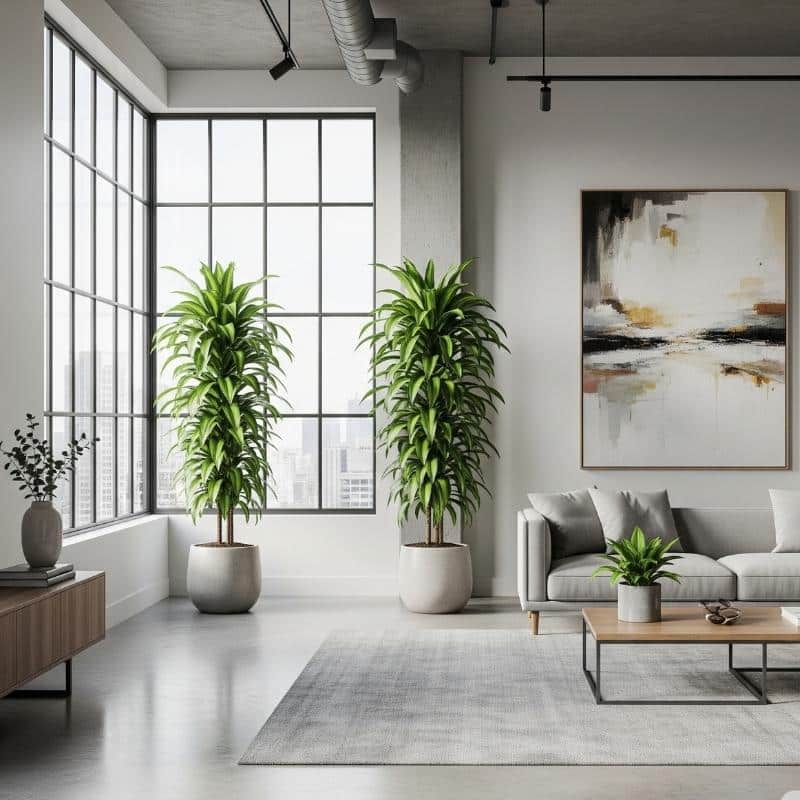
Creating a Statement Piece and Vertical Interest
With its tall, upright canes and lush foliage, a Corn Plant can instantly become a magnificent statement piece in your home. It adds incredible vertical interest, making rooms feel taller and more grand.
Complementing Various Decor Styles
Despite its height, the Corn Plant’s clean lines and classic look allow it to seamlessly fit into a wide variety of decor styles, from sleek modern and minimalist spaces to more classic or even bohemian settings. It’s truly versatile!
A Fantastic Air Purifier
Beyond its beauty, the Corn Plant is also a fantastic air purifier! It was highlighted in NASA’s Clean Air Study for its ability to filter common indoor toxins like formaldehyde, benzene, and trichloroethylene from the air. So, it’s not just gorgeous – it’s actively working to make your home healthier.
Perfect for Offices and Homes
Its easy-going nature, elegant look, and air-purifying benefits make the Corn Plant an ideal choice for both homes and office environments. It’s a low-fuss way to add impressive greenery!
The Allure of Corn Plants: Easy, Elegant, and Evergreen
The Corn Plant truly stands out as a top choice for indoor gardeners. It offers an unbeatable blend of easy-going care, a striking and elegant form, and the tangible benefit of purifying your air. Whether you’re looking for a low-maintenance giant, a touch of classic style, or simply a reliable green companion that gives back, the Corn Plant is a wonderfully rewarding choice. It’s a testament to enduring beauty that will enrich your home for years to come.
Frequently Asked Questions (FAQ) About Corn Plants
Still have some questions about your wonderful Corn Plant? Here are some common ones that might help you out!
Q1: Why are my Corn Plant’s leaf tips turning brown?
A1: Brown leaf tips are a very common issue for Corn Plants. The most frequent causes are fluoride or chlorine in tap water, inconsistent watering (letting the soil get too dry), or very low humidity.
- The Fix: Try using filtered water, distilled water, or rainwater. Ensure consistent watering, and occasionally mist the leaves if your air is very dry.
Q2: How often should I water my Corn Plant?
A2: Water your Corn Plant when the top 1–2 inches (2.5–5 cm) of soil feel dry to the touch, ensuring consistent moisture without overwatering. Water thoroughly until it drains out the bottom, then wait until the top few inches are dry again before the next watering. It’s better to slightly underwater your Corn Plant than to overwater, as they are more tolerant of dry conditions than soggy soil, which can lead to root rot.
Q3: Does a Corn Plant need a lot of light?
A3: Corn Plants thrive in bright, indirect light, which supports their optimal growth and helps maintain the vibrancy of their striped foliage. They can tolerate lower light, but their growth will slow, and variegation may fade. Avoid direct, harsh afternoon sun.
Q4: Can I cut the top off my Corn Plant?
A4: Yes, you absolutely can! This is a common way to control its height or to encourage new growth and branching. When you “top” a Corn Plant, new shoots will typically emerge from just below the cut on the cane, giving you a bushier plant. You can even propagate your Corn Plant by rooting the cut-off top! Simply place it in water or moist soil, and with proper care, it can grow into a new plant.
Q5: Is the Corn Plant toxic to cats and dogs?
A5: Yes, Corn Plants are considered toxic to cats and dogs if ingested. Corn Plants contain saponins, which are toxic to cats and can cause symptoms like vomiting, drooling, weakness, and potentially dilated pupils if ingested. Keep them out of reach of pets! It’s best to keep them out of reach of pets.
Q6: How tall can a Corn Plant get indoors?
A6: Indoors, with good care, a Corn Plant can typically reach heights of 4-6 feet (1.2-1.8 meters), and sometimes even taller, creating a lovely tree-like presence.
Q7: Why are the lower leaves of my Corn Plant turning yellow?
A7: Yellowing lower leaves on a Corn Plant are usually a sign of overwatering. Excess moisture in the soil can lead to root issues, so ensure proper drainage and adjust your watering routine. Adjust your watering schedule to let the soil dry out more between drinks. It can also be natural aging for older leaves, but this usually happens slowly.
Q8: Is the Corn Plant good for cleaning air?
A8: Yes, it is! The Corn Plant is renowned for its air-purifying abilities, helping to remove toxins and improve indoor air quality while adding a touch of greenery to your space. It was highlighted in NASA’s Clean Air Study for helping to remove common indoor air toxins like formaldehyde, benzene, and trichloroethylene.
Q9: Does a Corn Plant ever bloom indoors?
A9: It’s very rare for a Corn Plant to bloom indoors. When they do, they produce a tall stalk with small, fragrant white or yellow flowers. While the scent can be lovely, the blooms themselves are not typically the reason people grow them as houseplants.

